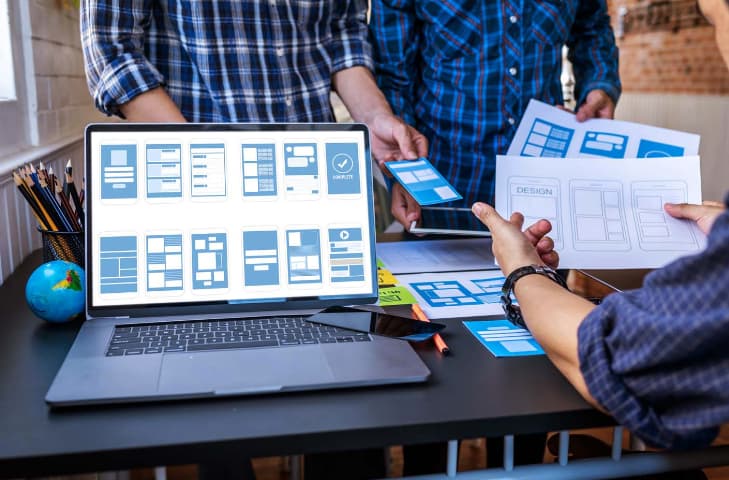UX design vs digital product design.. Can you think of a clear cut distinction between UX design and product design? Well, we are here to help you better understand both disciplines! In a nutshell, UX designers concentrate more on the practical design phase of the process, product designers are involved in every step of the creation of a product. Let’s go into details to get a better idea.
UX design vs digital product design

Making sure a person has a positive and seamless experience when using a website or app is known as user experience design or UX. It is designed to address crucial elements including usability, design, branding, and functionality throughout the whole process of acquiring and integrating the product.
With this in mind, the primary responsibility of the UX designer is to assist businesses in providing a positive user experience. This individual is in charge of:
- Using storyboards to convey future designs and other concepts to enhance product usability.
- Making prototypes for new features, goods, and websites.
- After evaluating items and prototypes, provide feedback.
- Examining website data and customer reviews to find areas for improvement.
- Incorporating digital design principles into interface design.
- Making or enhancing navigation to improve user experience.
- Executing experiments and research.
The importance of good UX design has also risen in recent years. Products from other companies that have the same features and address the same issue are available. The only way to achieve this is by providing a fantastic UX, which is why it has become a key priority to develop products that people choose over competitors.
Product design
The whole process of designing a product is within the purview of product designers. This covers all aspects of the product, from the initial design through the final version made available to the public, including upgrades made following the first release.
Daily duties for a product designer could include:
- Defining design specifications by briefs provided by other stakeholders.
- Identifying possibilities for additional features or products.
- Examining the potential links between a new product and current marketing, consumer, and corporate objectives.
- Enhancing the look of already existing items.
- Collecting useful product user input.
- Constructing and evaluating prototypes for new features or products.
- Presenting potential product designs to internal and external stakeholders.
A product designer may spend most of their time, depending on the organization, in the high-level planning and strategizing stages, then pass ideas and requirements to other designers for execution. Or, they might complete many useful design tasks on their own. The product designer is often a senior-level designer in any scenario, therefore they should be knowledgeable about every stage of the design process and the technology involved in each.
What similarities can you find?

About UX design vs product design, you could have already seen some clear parallels between the two jobs based on the aforementioned criteria. To begin with, both designers will use the design thinking process and have a human-centered perspective when creating designs. Both jobs involve some element of market research, however, the UX designer will inevitably spend more time on user testing.
Along with these shared characteristics, it’s usual for UX designers and product designers to work using the same design tools. Both designers frequently employ user mapping programmes like Lucid Chart and Overflow, as well as wireframing tools like Balsamiq and Sketch.
With a few exceptions, product designers and UX designers mostly employ the same technologies!
What distinguishes product design from user experience design?
Product design and UX design are different in that the latter focuses on ensuring that a user’s interaction with an app or website runs well, whilst the former handles more of the physical elements. Because they are creating how something functions, product designers avoid dealing with these issues or even what it should look like.
The two functions cooperate. There is no such thing as product vs. UX design. Product designers have a greater responsibility to take into account how the many parts of the product function together.
When designing for a phone, this entails making sure that the OS works well with the physical buttons on the side as well as touch and motion controls on the screen; when designing for a laptop or desktop computer, the hardware needs to be perfect, so you can use all the ports and connect displays without feeling overpowered by cables after unwrapping your new gadget.
The primary responsibility of the UX designer is to make sure that the user can achieve their objectives on the digital component of the product. Both UX and product designers use a variety of tools in their daily work.
For example, although product design is frequently done in a CAD programme like AutoCAD, UX designs are frequently created using Figma, Adobe XD, or Sketch.
Because they must take into account how all components will function as a single unit, product designers are more motivated to understand the larger picture.
read more:Product Design and Development: The foundation of everything
Becoming a product or user experience designer!

The pathways to UX design and product design may readily complement each other because they require the same skill sets to be developed. As you acquire expertise and start to take on additional responsibility, the leap from UX designer to product designer may come naturally.
You’ll want to hone your grasp of UX ideas and become acclimated to important design tools if you’re just beginning your design career. In further detail, here is what it means:
User-centric thinking is essential, but UX design is more than simply a way of thinking. UX ideas and skills A UX designer’s duties could also involve creating wireframes, prototypes, and maps of user flow.
These competencies will serve as the cornerstone of your work as a product designer.
Design concepts and tools: UX designers should normally be knowledgeable about a variety of design tools.
Examples include:
- Adobe Creative Suite
- Sketch
- Figma
It will also help to have a solid grasp of design fundamentals like typography and colour theory. It will also be advantageous to have the following abilities if you wish to advance into product design:
Project management experience is frequently required in job descriptions for product designers. You might be able to integrate this gradually into your present design position.
Collaboration amongst various teams: Product designers are anticipated to collaborate with business teams and may make their own judgments about the best practises based on data.
It will be crucial to have a comprehensive awareness of a product’s significance and corporate goals.










